

Sewing & Knitting Patterns. Patterns and copyright protections. In the United States, patterns are generally not eligible for copyright protection as copyright does not apply to methods or “procedures for doing, making, or building things.”
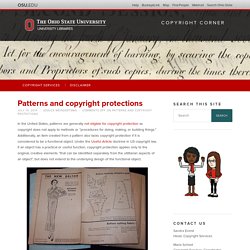
Additionally, an item created from a pattern also lacks copyright protection if it is considered to be a functional object. Under the Useful Article doctrine in US copyright law, if an object has a practical or useful function, copyright protection applies only to the original, creative elements “that can be identified separately from the utilitarian aspects of an object”, but does not extend to the underlying design of the functional object.
Photo: Butterick Dress 5579 Instr (c) Allison Marchant, CC BY-NC-SA 2.0 Here, while the drawing of the dress may be considered a creative expression of the author and therefore eligible for copyright protection, the pattern instructions and any dress made from the pattern would not be protected by copyright. “Copyright 2014. All Rights Reserved. Sewing pattern copyright law - myths debunked. There were a couple of articles in July that had a lot of interest, both about sewing to sell.
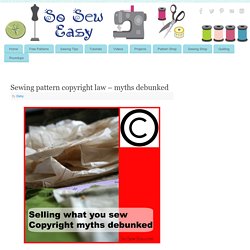
How to price your work and a round up of projects that are good to sell. Myer's "blatant" copies confirmed. This week designer Kim Khanbeigi, founder of US plus size label Kiyonna, confirmed recent claims by Australian e-tailer Style & Substance that Myer copied Kiyonna designs and that of another US brand Igigi, both of which are sold in Australia via Style & Substance.
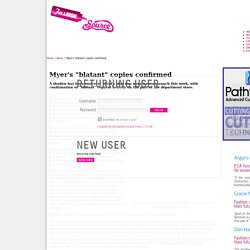
Khanbeigi said examination of the Myer garments involved had revealed that the designs of two of the garments were “100 per cent the same” as those of the Kiyonna brand. “On one of the two, the construction is 100 per cent the same and on the other one stitch is different,” Khanbeigi said, adding her reaction on learning that Myer had replicated her designs was “disappointment”. “We are in the business of creating, and so much blood, sweat and tears goes into each concept from the fit to the styling, it's just plain disappointing when someone else takes the hard work of another (in this case the Kiyonna team), and claims it as their own.
Myer’s copying of the designs did a disservice to plus size women, she added. Sewing Pattern Copies or Photocopies NOT copyright Free. Copyright Notice 4 2015. Free Vintage Sewing Patterns: ♥ The (Non-) Copyright Issue ♥ First off, let me say that even the experts admit that copyright is a VERY confusing topic, with a large gray area.

Before deciding to flame me for my conclusions, be sure you have read the entire page AND THE LINKS. And it may take more research than that to GRASP the issue. Having spent a fair amount of time at the US Copyright website and in general research, I feel prepared to proceed. There are many misconceptions about copyright laws, including the common opinion that, "if you didn't create it or pay for it, your use is illegal. " I can understand how many companies and individuals, because of the large gray area referred to above, have opted for this method of dealing with copyright laws. However, this is NOT THE LAW. So what does the LAW say about using things that are under copyright? The simple (though still complicated) answer: Works that have passed out of copyright. The super simple answer: if it was published after 1964, it is still under copyright. Nunavut family outraged after fashion label copies sacred Inuit design - Home. Wednesday November 25, 2015 Originally published: Nov. 25, 2015 Updated: Nov. 27, 2015.
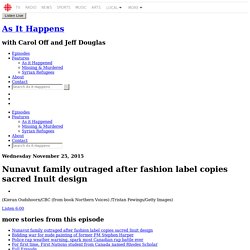
For latest on company's apology go here. It's a caribou skin parka originally made to offer spiritual protection to an Inuit shaman named Ava. But now a Nunavut family has discovered that high-end European clothing designer, Kokon To Zai, has been selling the sacred design as a sweater. "I was furious. U.K. fashion house pulls copied Inuit design, here's their apology Canadian retailer pulls 'stolen' sacred Inuit design from stores.
Target caught ripping off design from Melbourne business Peaches and Keen for children's clothing. Updated Australia's biggest retailer Wesfarmers is facing tough questions about its design practices after being caught ripping off the work of a tiny Melbourne company.
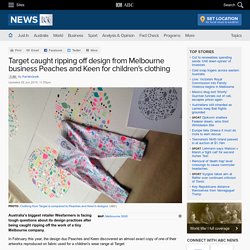
In February this year, the design duo Peaches and Keen discovered an almost exact copy of one of their artworks reproduced on fabric used for a children's wear range at Target. Wesfarmers owns Target, along with Coles, Kmart and Bunnings. "We found out that we had had our work used without our knowledge via Facebook," Peaches and Keen co-founder Lily Daley said. "We actually had a fan ... send us a message on Facebook asking us if we were producing work for the company. IP Fashion Rules. As a Fashion Designer, you are in the business of creating IP.
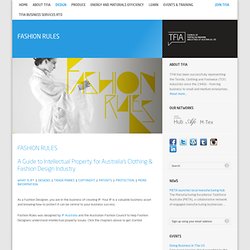
Your IP is a valuable business asset and knowing how to protect it can be central to your business success. Fashion Rules was designed by IP Australia and the Australian Fashion Council to help Fashion Designers understand intellectual property issues. Click the chapters above to get started.